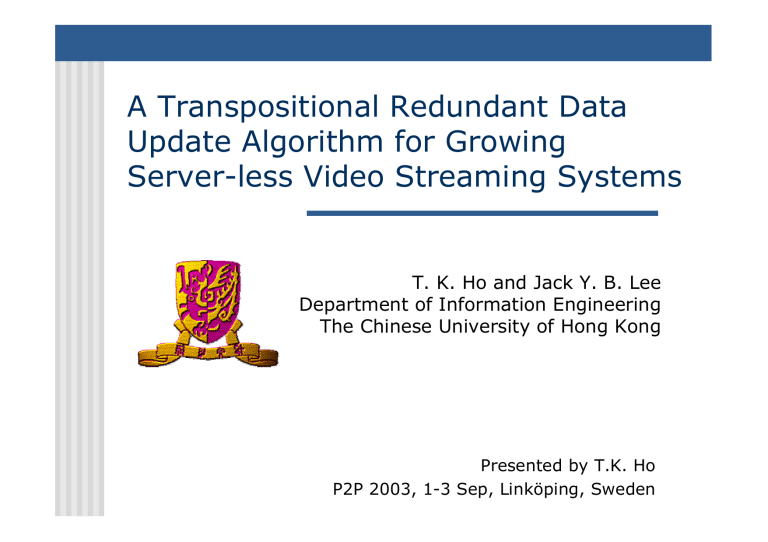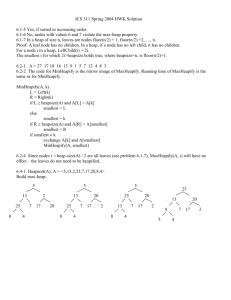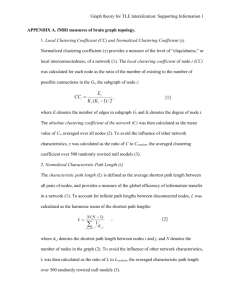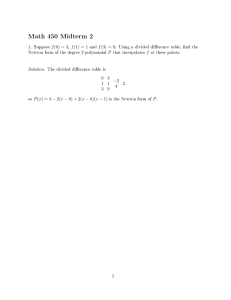A Transpositional Redundant Data Update Algorithm for Growing Server-less Video Streaming Systems

A Transpositional Redundant Data
Update Algorithm for Growing
Server-less Video Streaming Systems
T. K. Ho and Jack Y. B. Lee
Department of Information Engineering
The Chinese University of Hong Kong
Presented by T.K. Ho
P2P 2003, 1-3 Sep, Linköping, Sweden
Outline
Background
Previous Works
Transpositional Redundant Data
Update (TRDU)
Multiple Redundant Nodes
Performance Evaluation
Conclusion and Future Works
Background
Server-less Video Streaming Systems[1]
Pool of user hosts, or call nodes
Each node acts as both sender and receiver
Data redundancy to achieve reliability
Data
Nodes
Receiver
Network
Redundant
Nodes
[1] Jack Y. B. Lee and W. T. Leung, “Study of a Server-less Architecture for Video-on-Demand Applications,” Proc. IEEE
International Conference on Multimedia and Expo.
, August 2002.
Background
Data Placement Policy
Data Nodes Redundant Nodes d
0 v
0
Q-bytes Data
Blocks v
4 v
8 v
12 v
16 v
20 d
1 v
1 v
5 v
9 v
13 v
17 v
21 d
2 v
2 v
6 v
10 v
14 v
18 v
22 d
3 v
3 v
7 v
11 v
15 v
19 v
23 r
0 c
0,0 c
1,0 c
2,0 c
3,0 c
4,0 c
5,0 r
1 c
0,1 c
1,1 c
2,1 c
3,1 c
4,1 c
5,1
Same Parity
Group
Q-bytes
Redundant
Data Blocks
Background
New nodes join the system
Video data blocks are reorganized to utilize their storage and streaming capacity
Video data blocks in the parity group change
Redundant data blocks need updating
Transmitting video data blocks to redundant nodes d
0 d
1 d
2 d
3 d
4 d
5 r
0 r
1 v
0 v
1 v
2 v
3 v
4 c’
0,0 c’
0,1 v
5
Data Blocks in Parity Group
CHANGE !
v
6 v
12 v
18 v
7 v
13 v
19 v
8 v
14 v
20 v
9 v
15 v
21 v
10 v
16 v
22 v
11 v
17 v
23 c’
1,0 c’
2,0 c’
3,0 c’
1,1 c’
2,1
Redundant Data
Blocks CHANGE !
c’
3,1
Previous Works
Redundant Data Regeneration
Data blocks are fully distributed
•
Transmit all data blocks to redundant node
•
Compute the new redundant data in redundant node
•
Overhead is too high
Data
Nodes
Redundant
Node
Previous Works
Redundant Data Regeneration
All data blocks stored in central server
•
Regenerate new redundant data in server
•
Transmit them to redundant node
•
Overhead is low
•
Costly for server, not desirable/ feasible
Central
Server
Redundant
Node
Previous Works
Sequential Redundant Data Update (SRDU)
Old redundant blocks contain valuable information
Possible to reuse for linear code, e.g. RSE code
Vandermonde matrix
•
Number of nodes, N
•
Number of redundant nodes, h
•
Element at row i, column j = j i-1
c i ,0
Redundant block in redundant node 0
c i ,1
c
,
−
1
=
1 1 1
1 2 3 h
−
1
1 2 3 h
−
1
…
…
…
1
( ) h
−
1
d d i d i
,0
,1
− −
1
block from data node 0
Previous Works
Updating parity group 0
Before addition of nodes d
0 d
1 d
2 d
3 r
0 v
0 v
1 v
2 v
3 c
0,0 r
1 c
0,1 c
0,1
=
1* v
0
+
2* v
1
+
3* v
2
+
4* v
3 d
0 v
0
After addition of two nodes d
1 v
1 d
2 v
2 d
3 v
3 d
4 v
4 d
5 v
5 c '
0,1
= c
0,1
+
5* v
4
+
6* v
5 r
0 c’
0,0 r
1 c’
0,1
c
0,0 c
0,1
1 1 1 1
1 2 3 4 v
v
0
1
2 v
3
c '
0,0 =
1 1 1 1 1 1 c '
0,1
1 2 3 4 5 6
Only need to send v
4, v
5 v
0
v
1
v
v v
5
4
Previous Works v
6
Updating parity group 1
Before addition of nodes d
0 d
1 d
2 d
3 r
0 r
1 d
0 v
8 v
9 v
10 v
11 c
2,0 c
2,1
=
1* v
8
+
2* v
9
+
3* v
10
+
4* v
11 c
2,1
After addition of two nodes d
1 d
2 d
3 d
4 d
5 r
0 v
7 v
8 v
9 v
10 v
11 c '
1,1
= c
2,1
+
5* v
6
+
6* v
7 c’
1,0 r
1 c’
1,1 c
2,0
1 1 1 1
1 2 3 4
v v v
9
8
10 v
11
c '
1,0 =
1 1 1 1 1 1
c '
1,1
1 2 3 4 5 6
Only need to send v
6, v
7 v
8
v
9
v
v
11 v
7
6
Previous Works
Problem in SRDU
Reusing of old redundant block is limited c
’
0,1 can only be in term of one of c
0,1 and c
1,1
Both c
0,1 and c
1,1 are constructed by multiplying 1 to 4 with the data blocks d
0 d
1 d
2 d
3 d
4 d
5 d
6 d
7 r
0 r
1 v
0 v
8 v
1 v
9 v
2 v
10 v
3 v
11 v
4 v
12 v
16 v
17 v
18 v
19 c '
0,1
= c
0,1
+ j
7
∑
=
4
( j
+
1) * v j v
20 v
5 v
13 v
21 v
6 v
14 v
7 v
15 c’
0,0 c’
1,0 c’
0,1 c’
1,1 v
22 v
23 c’
2,0 c’
2,1 c '
0,1
= c
1,1
+ j
3
∑
=
0
( j
+
5)* v j
Transpositional Redundant
Data Update
Compute redundant block using transposed coefficients
Vandermonde matrix
(N max
-h) columns
N max is max system size, irrespective of current size N
c i ,0
1 1 1 c i ,1
1 2 3
c
,
−
1
1 2 h
−
1
3 h
−
1
…
…
…
N max
1
− h
( N max
− h ) h
−
1
d d d i ,0 i ,1
, max
− −
1
Transpositional Redundant
Data Update v
0 v
4 v
8 d
0
For parity group i, the starting position is shifted by (i(N-h) mod (N max
-h) )
All other elements are zeroed
Example
Let (N max
-h) be 10
Parity group 0 d
1 v
1 v
5 v
9 d
2 v
2 v
6 v
10 d
3 v
3 v
7 v
11 r
0 c
0,0 c
1,0 c
2,0 r
1 c
0,1 c
1,1 c
2,1
c
0,0 c
0,1
1 1 1 1 1
1 2 3 4 5 v
0
v v
1
2
1
10 v
3
c
0,1
=
1* v
0
+
2* v
1
+
3* v
2
+
4* v
3
Transpositional Redundant
Data Update
Parity group 1 and 2 c
1,1
=
5* v
4
+
6* v
5
+
7* v
6
+
8* v
7
0
0
v
4 v
»
7 d
0 d
1 d
2 d
3 r
0 r
1 v
0 v
4 v
8 v
1 v
5 v
9 v
2 v
6 v
10 v
3 v
7 v
11 c
0,0 c
1,0 c
2,0 c
0,1 c
1,1 c
2,1 c
2,1
=
9* v
8
+
10* v
9
+
1* v
10
+
2* v
11 v
10
v
11
Repeat coefficient in c
2,1
Max size of 10 prevents v
0 and v residing in the same parity group
10 in
v
8 v
9
Transpositional Redundant
Data Update
Two nodes are added
Updating parity group 0 d
0 v
0 v
6 d
1 v
1 v
7 d
2 v
2 v
8 d
3 v
3 v
9 d
4 v
4 v
10 d
5 v
5 v
11 r
0 c’
0,0 c’
1,0 r
1 c’
0,1 c’
1,1 c '
0,1
=
1* v
0
+
2* v
1
+
3* v
2
+
4* v
3
+
5* v
4
+
6* v
5 c
0,1
5* v
4
+
6* v
5
c c
'
0,0
'
0,1
=
1 1 1 1 1
1 2 3 4 5
Need to send v
4, v
5 v v v v
3
0
1
1
10 v v
5
4
Transpositional Redundant
Data Update d
0 v
0 v
6
Updating parity group 1 d
1 v
1 v
7 d
2 v
2 v
8 d
3 v
3 v
9 d
4 v
4 v
10 d
5 v
5 v
11 r
0 c’
0,0 c’
1,0 r
1 c’
0,1 c’
1,1 c '
1,1
=
(7* v
6
+ v
7
+ v
8
+
10* v
9
+
1* v
10
+ v c 5* v
4
− v
5
+ c
2,1
c c
'
1,0
'
1,1
=
1 1 1 1 1
1 2 3 4 5
No need to send
1
10 v v
10
11
0
v
6
v v
7
8 v
9
Cached in previous update
This equation is not allowed in SRDU, as v
6 same coefficient with v
10 shares the
Transpositional Redundant
Data Update
In SRDU
Before addition of nodes c
1,1
=
1* v
4
+
2* v
5
+
3* v
6
+
4* v
7 c
2,1
=
1* v
8
+
2* v
9
+
3* v
10
+
4* v
11
After addition of two nodes c '
1,1
=
(1* v
8
+
2* v
9
+
3* v
10
+ v
11
+ v
6
+
c '
1,0 =
1 1 1 1 1 1 c '
1,1
1 2 3 4 5 6
v
7 v
8
v
9
v
v v
7
6 c 5* v
6
+
6* v
7
Transpositional Redundant
Data Update
Zero overhead point
Number of additional nodes equals integral multiples of original system size d
0 v
0 d
1 v
1 d
2 v
2 d
3 d
4 d
5 v
3 c '
0,1 v
4 v
5
= c
0,1
+ c
1,1 v
6 d
6 d
7 v
7 r
0 c’
0,0 r
1 c’
0,1
Tradeoffs
Specify the max system size N max
Larger Vandermonde matrix increases the computational complexity in decoding
Multiple Redundant Nodes
Total number of data blocks, B
Redundant Data Regeneration
Fully distributed data blocks
•
Total overhead = B + (h-1)(B/(N-h))
All data blocks are sent, overhead = B
...
All redundant data are constructed here
...
...
overhead = B / (N-h)
Multiple Redundant Nodes
Data blocks are stored in central server
•
Total overhead = h * B/(N-h)
All redundant data are constructed in server
...
...
overhead = B / (N-h)
Multiple Redundant Nodes
SRDU/TRDU
Total overhead = blocks under SRDU/TRDU + (h-1)(B/(N-h))
Blocks under TRDU or
SRDU are transmitted
...
Compute partial result of each new redundant blocks
P
=
5* v
4
+
6* v
5
...
...
overhead = B / (N-h) c '
1,1
= c
1,1
+
P
Combine the old redundant data and received partial result
Multiple Redundant Nodes
Overhead is dominated by updating the first redundant node
Performance Evaluation
Simulation Details
One redundant node
One video title
40,000 data blocks
Metric
Redundancy Update Overhead
•
Number of video data blocks needed to transmit for generating the new redundant data
Performance Evaluation
Continuous system growth
•
Grow from 1 node to 400 nodes
•
One node added each time
100000
Regeneration by Fully Distributed Data
SRDU
10000
TRDU
1000
Regeneration by Archive Server
100
0 100 200
System Size (nodes)
300 400
Performance Evaluation
Batched redundancy update
•
Defer update until a fixed number of nodes, W
•
Initial system size = 80, W ranges from 1 to 200
100000
10000
1000
SRDU, Starting at 80
100
10
0
TRDU, Starting at 80
Zero O verhead Points
50 100
Batch Size W (nodes)
150 200
Conclusion
Reduce the redundancy update overhead significantly by
TRDU
Batched update
Overhead in multiple redundant nodes is investigated
Additional overhead is insignificant
Future Works
Node Removal
Addition of redundant nodes
Scheduling problem
Optimal batch size
Thank you
Q&A Section







